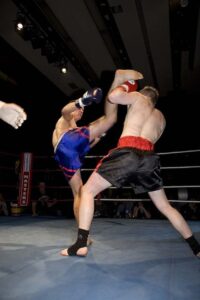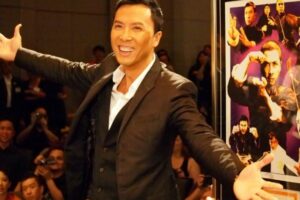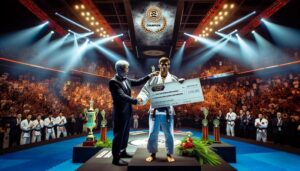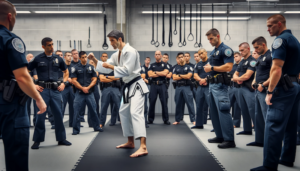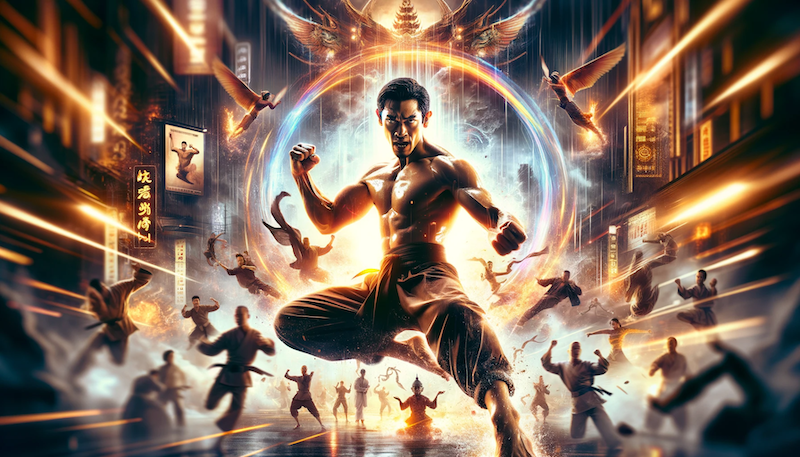
Do you have some questions about Tony Jaa’s martial arts style, background, movies, and arts known?
In this article, we explore the martial arts Tony Jaa knows, his martial arts style, background, movies, and whether he can fight for real.
Contents
What Martial Arts Does Tony Jaa Know?
Tony Jaa knows 7 martial arts: Muay Thai, Muay Boran, krabi-krabong, wushu, judo, taekwondo, and Brazilian jiu-jitsu.
Let’s take a closer look at the martial arts Tony Jaa knows or has had experience with, and the order he did so.
1. Muay Thai
The first martial art Tony Jaa learned was Muay Thai. He started practicing the art of eight limbs while alone at his local temple school, at the age of 10.
Muay Thai is a combat sport from Thailand known for its stand-up striking and clinching techniques. It utilizes a symphony of punches, kicks, elbows, and knee strikes, making it distinctively effective and dynamic.
Before this, Tony Jaa initially practiced and self-taught the techniques he’d seen in movies, inspired by his favorite martial arts stars: Bruce Lee, Jackie Chan, and Jet Li.
At age 15, Jaa’s competence in Muay Thai techniques helped him secure work under Panna Rittikrai, an experienced Thai martial arts action choreographer, director, and actor.
Under Panna’s guidance, Tony Jaa went to Sarakham College of Physical Education and earned a BA.
He then spent the next 14 years working as a stuntman, particularly for Muay Thai movies. Here, he continued to develop his Muay Thai techniques and proficiency in the martial art.
2. Krabi-Krabong
Tony Jaa also learned some krabi-krabong when under the guidance of Panna Rittikrai. Krabi-Krabong is a traditional Thai martial art that emphasizes the use of weapons, particularly swords, and staffs, alongside various other weapons.
It’s known for its acrobatic techniques and elements from Muay Thai/Muay Boran such as punches, elbow strikes, knee strikes, and kicks.
Krabi-krabong also incorporates clinches and throws, focusing on grappling and clinching maneuvers to unbalance the opponent.
The art also utilizes joint locks and holds, aimed at immobilizing or controlling the opponent, often seamlessly transitioning from weapon-based tactics to unarmed combat.
Tony Jaa continued to practice krabi-krabong, especially his skills with weapons. This skill can be seen throughout his movie career. For example, his extensive use of a bo staff, katana, and three-section staff in the Ong-Bak movies.
3. Muay Boran
Building on his existing Muay Thai skills, Tony Jaa started to learn Muay Boran while at the Sarakham College of Physical Education.
Muay Boran is an ancient Thai martial art, recognized as the precursor to modern Muay Thai. Translating to “ancient boxing”, it was originally developed for warfare and was taught to Thai armies.
Muay Boran uses the same Muay Thai striking techniques but it also encompasses headbutts, grappling, joint locks, holds, and ground fighting.
4. Wushu
With a connection to Panna Rittikrai and work as a stuntman lined up after he completed his degree, it made natural sense for Tony Jaa to start wushu while studying.
Wushu is an umbrella term for many forms of Chinese martial arts (kung fu) which are practiced for full-contact combat sport (sanda) or as a demonstration of techniques and forms (taolu).
Tony Jaa learned wushu-taolu, as it would help him refine his techniques and improve his balance, flexibility, and stage performance. These would help him in his work as a stuntman and as a future martial arts actor.
Tony Jaa would continue to improve his wushu-taolu skills throughout his acting skills, as he continued to work with those skilled in the art. Jet Li and Jackie Chan are two such actors.
When promoting Ong-Bak, Tony Jaa went around America and performed a martial arts (wushu) demonstration to show his acrobatics, martial arts techniques, and fitness.
5. Judo
At this point in college, the next logical martial art for Tony Jaa to learn was judo, as he was already proficient in striking martial arts.
Founded in 1882 by Jigoro Kano, judo is a Japanese grappling martial art and Olympic sport focused on throws, takedowns, and ground control techniques and submissions.
Learning judo would help Tony become a more complete martial artist who could perform throws, takedowns, and submissions – all techniques that look epic on screen.
If he were to succeed as a stuntman, Tony Jaa needed to learn how to perform many grappling techniques which require judo knowledge and expertise.
For example, he needed to be able to safely land on the ground/mats when being thrown and taken down. This he all learned through judo while in college.
6. Taekwondo
The last martial art Tony Jaa studied while at college was taekwondo. Taekwondo is a Korean martial art characterized by its emphasis on head-height kicks, jumping and spinning kicks, and fast kicking techniques.
Many martial arts actors have added taekwondo to their repertoire, especially since Bruce Lee was the first major martial arts star to do so.
Bruce Lee realized that the high, spinning, acrobatic, and flashy kicking techniques of taekwondo looked brilliant in martial arts movies.
7. Brazilian Jiu-Jitsu
While Tony Jaa is predominantly known for his expertise in Muay Thai and Krabi-Krabong, his filmography suggests a familiarity with Brazilian jiu-jitsu (Bjj) techniques as well.
Bjj is a martial art focusing on ground fighting and grappling and is known for its emphasis on joint locks, chokeholds, and positional control.
In Ong Bak 2, Jaa’s character, Tien, demonstrates skills reminiscent of jiu-jitsu. The film features a ritualized sparring sequence where Tien employs techniques such as takedowns and armbars, common in Bjj.
These moves align with jiu-jitsu’s core principles of neutralizing an opponent through leverage and technique rather than brute strength.
Jaa’s potential training in Bjj or exposure to its techniques could also be attributed to his collaborations with various fight choreographers and martial artists in the film industry, who have expertise in Brazilian jiu-jitsu.
While it’s unknown who taught him Bjj for Ong-Bak 2, Tony Jaa worked alongside many martial arts with expertise in Brazilian jiu-jitsu when filming Triple Threat (2019). They are:
- Michael Jai White – Plenty of Bjj and MMA experience
- Scott Adkins – Used lots of Bjj techniques in MMA movies
- Michael Bisping – Bjj brown belt and former UFC champion
Tony Jaa Martial Arts Background
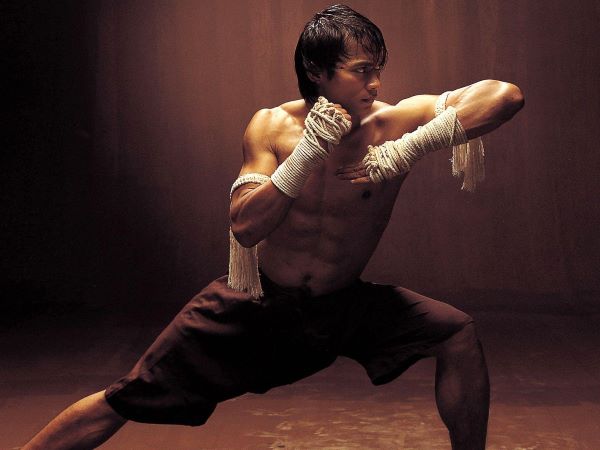
Tony Jaa, a renowned Thai martial artist, actor, action choreographer, stuntman, acrobat, and traceur, has a rich background in martial arts, inspired by his early admiration for legends like Bruce Lee, Jackie Chan, and Jet Li.
From a young age, Jaa was drawn to the dynamic world of martial arts, a passion that was fueled by the movies of his idols. His journey into martial arts began in earnest at the age of 10 when he started training in Muay Thai.
At age 15, Jaa’s dedication saw him trekking through the jungles from his home in Surin, near the Thai-Cambodian border, to a village called Maha Sarakham.
There, he would engage in rigorous training sessions under the guidance of former Thai action movie hero Phanna Rithikrai.
Jaa’s training was comprehensive, encompassing various martial arts and weapons. This period of intense learning laid the foundation for his diverse skill set, which he later showcased in his films.
His gymnastic skills, which started at an even younger age, were honed in his father’s rice paddies, where he would perform acrobatic feats such as jumping onto his pet elephants and somersaulting into the river.
Working on film sets from a young age, Jaa gained invaluable experience in the practical aspects of filmmaking.
His first significant opportunity came when he worked as a stunt double for Robin Shou in “Mortal Kombat: Annihilation” (1997) at the age of 23.
While working here, Tony earned the nickname, ‘Mr. Hollywood’, because his skills and acrobatics were that impressive.
This experience on set, coupled with his mentorship under Phanna Rithikrai, solidified his aspiration to become one of the best martial arts actors.
When speaking to Scott Adkins, Tony Jaa expressed how he used to train 8 hours per day for 4 days per week in preparation for his movie roles.
He would run 20 kilometers, followed by gymnastics, stretching, and speed training, before practicing fight techniques with the stunt team.
Tony Jaa’s Martial Arts Style
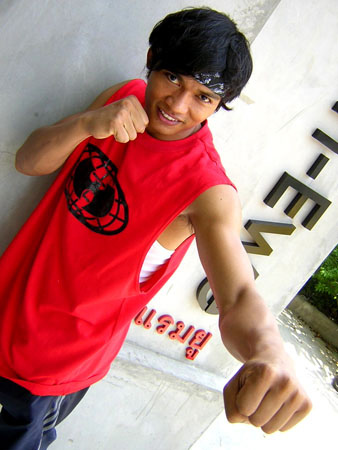
Although Tony Jaa is proficient in several martial arts, his martial arts style primarily revolves around Muay Thai, Muay Boran, and Krabi-Krabong, three martial arts native to his home country, Thailand.
This focus is a deliberate choice to showcase the rich Thai fighting martial arts tradition in his movies. This would separate him from other martial arts actors.
His unique fighting style blends acrobatics, speed, agility, and fluid movements with power and aggressive attacks, especially with leg strikes.
This makes his action sequences both visually stunning and authentically representative of Thai martial arts.
In his films, Jaa often employs flying elbow strikes, flying knees and kicks,
In his films, Tony Jaa’s foundation in Muay Thai is evident in the powerful and flying elbow and knee strikes that have become a signature aspect of his on-screen persona, as well as his constant use of devastating roundhouse, front, and side kicks.
His Muay Boran and krabi-krabong style is evident when he uses grappling techniques such as joint locks and holds to immobilize and break the bones of his opponents.
Jaa’s proficiency in krabi-krabong is also showcased through his adept use of traditional weapons like swords, staffs, and even improvised weapons, reflecting the art’s emphasis on adaptability in combat.
This skill is particularly highlighted in the “Ong Bak” series, where his character deftly wields a variety of weapons, demonstrating both precision and creativity.
Beyond these traditional Thai martial arts, Jaa’s style is enriched by his background in gymnastics and Taekwondo.
This is seen in his acrobatic and flashy kicking techniques, which add an element of spectacle to his fight scenes.
He has come up with his kicking techniques such as the double 540 kicks and the front flip front kick (stomp-like) that are heavily used in the Ong-Bak movies.
His ability to perform high-flying, spinning kicks, and agile movements is a testament to his physical prowess and adds a unique flair to his martial arts style.
Jaa’s experience as a stuntman further enhances his martial arts style. He often incorporates complex and daring stunts into his fight choreography, adding a layer of realism and intensity that other martial arts actors can’t match.
Moreover, Jaa’s films often feature influences from other martial arts styles, such as capoeira and Brazilian jiu-jitsu.
For example, in The Protector, he seamlessly integrates capoeira and taekwondo techniques into his fighting style, demonstrating his versatility as a martial artist.
His use of Bjj techniques, such as joint locks and ground control, showcases his adaptability and understanding of various combat disciplines.
In summary, Tony Jaa’s martial arts style is a dynamic amalgamation of traditional Thai martial arts, taekwondo, acrobatic prowess, and diverse influences from other martial arts disciplines.
His ability to blend these elements into a cohesive and effective fighting style has made him a standout figure in the world of action cinema, captivating audiences with his speed, agility, and the sheer power of his techniques.
Can Tony Jaa Fight For Real?
No, Tony Jaa can’t fight for real. He has zero competitive or real fight experience. Against a trained competitor in either Muay Thai or judo, for example, Tony Jaa would most likely lose.
However, against untrained people in the street, he’d more than likely be able to hold his own – although he does only weigh between 130 and 140 lbs – so he’s not a big man.
While he’s an exceptionally gifted martial artist in terms of physical performance and choreography, his expertise is tailored towards cinematic martial arts rather than actual combat or competitive fighting.
Tony Jaa’s training, heavily influenced by iconic martial arts actors like Jackie Chan, Bruce Lee, and Jet Li, has been focused on emulating their on-screen styles.
This involves developing a high level of technical skill, timing, acrobatics, and choreography, essential for dramatic and visually stunning fight scenes.
However, this type of training is distinct from the preparation required for real-life fighting or competitive martial arts.
In the realm of professional Muay Thai, fighters often start training at a very young age and engage in numerous fights throughout their careers.
This real-world fighting experience, crucial in competitive settings, is something that Jaa hasn’t pursued.
His training in Muay Thai and taekwondo has given him a solid foundation in martial arts, but without competitive fighting experience, it’s geared more towards performance rather than actual combat.
Therefore, while Jaa’s martial arts prowess is impressive and should be appreciated for its cinematic brilliance, it doesn’t translate into real fighting ability in a competitive or combative context.
Tony Jaa’s Martial Arts Movies
Tony Jaa’s filmography is a testament to his martial arts prowess, showcasing a variety of styles and techniques. Here’s a brief overview of some of his notable movies and the martial arts elements featured in them:
Ong-Bak: Muay Thai Warrior (2003): This film put Jaa on the international map, highlighting his expertise in Muay Thai. The movie features intense fight scenes with authentic Muay Thai techniques, including devastating strikes and clinch fighting.
The Protector (2005): Jaa’s character embarks on a mission to rescue his stolen elephant, leading to action sequences that blend Muay Thai with other martial arts. The film is famous for its single-shot hallway scene, showcasing Jaa’s skill and dedication.
Ong-Bak 2: The Beginning (2008): Set in ancient Thailand, this movie combines various martial arts styles, with Jaa portraying intense fight sequences and a journey of self-discovery.
SPL II: A Time for Consequences (2015): Jaa displays his Muay Thai techniques in a plot involving black market organ theft, featuring prison brawls and a final showdown.
Triple Threat (2019): Jaa teams up with other mercenaries to protect a billionaire’s daughter, blending Muay Thai with other martial arts. The film includes high-octane chases and fight sequences.
Ong-Bak 3 (2010): Continuing the story of Prince Tien, Jaa’s portrayal combines Muay Thai with a narrative of redemption and revenge.
The Protector 2 (2013): Jaa returns as Kham, showcasing his Muay Thai expertise in various action-packed scenes, including a gripping rooftop chase.
SPL: Kill Zone (2005): As a top enforcer, Jaa defends a crime lord’s empire with unmatched martial arts prowess, featuring visceral fight scenes.
Furious 7 (2015): Jaa brings a new intensity to the Fast & Furious franchise, with his character Kiet showcasing Muay Thai in a memorable confrontation.
Skin Trade (2014): Jaa stars as a Thai detective, with his signature Muay Thai moves highlighted in a showdown with Michael Jai White.
Paradox (2017): Jaa plays a Thai police officer, blending Muay Thai and traditional combat styles in a plot involving a missing daughter.
Master Z: Ip Man Legacy (2018): Jaa’s character showcases a blend of Muay Thai and traditional martial arts in electrifying confrontations.
The Bodyguard (2004): Jaa plays a bodyguard using his martial arts skills to protect and unravel a conspiracy.
The Bodyguard 2 (2007): Portraying a top agent, Jaa blends humor with martial arts sequences set against a backdrop of suspense.
Monster Hunter (2020): Jaa stars as Hunter, showcasing martial arts prowess in battles against monstrous creatures.

